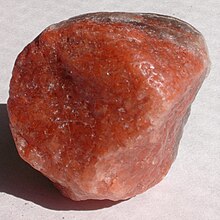Magnesium chloride
| Crystal structure | |||||||||||||||||||
|---|---|---|---|---|---|---|---|---|---|---|---|---|---|---|---|---|---|---|---|

|
|||||||||||||||||||
| __ Mg 2+ __ Cl - | |||||||||||||||||||
| General | |||||||||||||||||||
| Surname | Magnesium chloride | ||||||||||||||||||
| other names | |||||||||||||||||||
| Ratio formula | MgCl 2 | ||||||||||||||||||
| Brief description |
colorless, bitter-tasting, deliquescent, hexagonal crystals |
||||||||||||||||||
| External identifiers / databases | |||||||||||||||||||
|
|||||||||||||||||||
| properties | |||||||||||||||||||
| Molar mass | |||||||||||||||||||
| Physical state |
firmly |
||||||||||||||||||
| density | |||||||||||||||||||
| Melting point | |||||||||||||||||||
| boiling point |
1412 ° C (anhydrous) |
||||||||||||||||||
| solubility | |||||||||||||||||||
| safety instructions | |||||||||||||||||||
|
|||||||||||||||||||
| As far as possible and customary, SI units are used. Unless otherwise noted, the data given apply to standard conditions . | |||||||||||||||||||
Magnesium chloride , MgCl 2 , is the magnesium salt of hydrochloric acid . It forms several hydrates .
Occurrence

Magnesium chloride occurs naturally in the mineral bischofite (MgCl 2 • 6H 2 O) and as the double salt carnallite (KMgCl 3 • 6 H 2 O). Another natural source is sea water . In some salt lakes , the concentration of magnesium ions is even higher than that of sodium ions.
Extraction and presentation
The industrial production of magnesium chloride takes place by evaporating the final liquors from the production of potassium chloride . The magnesium chloride hexahydrate (MgCl 2 · 6H 2 O) is obtained first. Further evaporation yields a product with less water. Anhydrous magnesium chloride is obtained by reacting magnesium oxide with carbon and chlorine :
In the laboratory, magnesium chloride can be made from magnesium hydroxide and hydrochloric acid
or by reacting magnesium with hydrochloric acid
be won.
properties
Magnesium chloride is very hygroscopic . Its tendency to hydrolysis is less pronounced than that of aluminum chloride (AlCl 3 ). Anhydrous magnesium chloride crystallizes in the CdCl 2 grid type. The standard enthalpy of formation of magnesium chloride is −642 kJ mol −1 .
The compound forms stable solvates with methanol and ethanol at room temperature . With methanol, solvates of stoichiometry 1: 2, 1: 3, 1: 4, 1: 6 and 1: 8 based on magnesium chloride and with ethanol solvates of stoichiometry 1: 2, 1: 3, 1: 4 and 1: 6 produced and characterized on magnesium chloride.
use
Magnesium chloride is used to extract elemental magnesium by means of fused- salt electrolysis :
It is used together with magnesium oxide in screed cements.
In food technology, magnesium chloride is used as an acid regulator , firming agent , flavor enhancer , carrier or release agent. It is approved in the EU as a food additive with the number E 511 without a maximum quantity restriction ( quantum satis ) for all foodstuffs approved for additives as well as for organic food . It is the main component of the coagulant Nigari and is used in the production of tofu . It is still used as a road salt supplement .
Magnesium chloride is also used to increase the magnesium concentration in reef aquariums.
It is also used to bind dust (explosion protection) in hard coal mining.
It was experimentally used in a lye called anti - dustite to bind road dust .
As Magnesium Oil , a saturated magnesium chloride-water solution with an oily consistency, it is used in concentrated form in alternative medicine for transdermal magnesium substitution (absorption through the skin). There is no scientific evidence for this.
As a thermal battery, magnesium chloride hexahydrate can store and release heat energy.
Individual evidence
- ↑ Entry on E 511: Magnesium chloride in the European database for food additives, accessed on June 27, 2020.
- ↑ Entry on MAGNESIUM CHLORIDE in the CosIng database of the EU Commission, accessed on March 6, 2020.
- ↑ a b entry on magnesium chloride. In: Römpp Online . Georg Thieme Verlag, accessed on July 14, 2014.
- ↑ a b c d e f Entry on magnesium chloride in the GESTIS substance database of the IFA , accessed on May 7, 2017(JavaScript required) .
- ^ Richard C. Ropp: Encyclopedia of the Alkaline Earth Compounds . Newnes, 2012, ISBN 0-444-59553-8 , pp. 44 ( limited preview in Google Book search).
- ↑ Data sheet Magnesium chloride, anhydrous at Sigma-Aldrich , accessed on May 7, 2017 ( PDF ).
- ↑ Korhammer, K .; Mihaly, J .; Balint, S .; Trif, L .; Vass, A .; Tompos, A .; Talas, E .: Reversible formation of alcohol solvates and their potential use for heat storage in J. Therm. Anal. Calorim. 138 (2019) 11-33, doi : 10.1007 / s10973-019-08090-2 .
- ↑ Heat storage from salt, article from 2012




